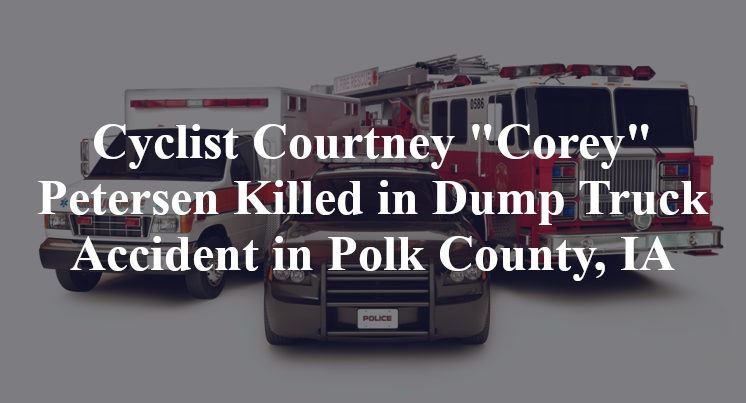Cyclist Courtney “Corey” Petersen Killed in Dump Truck Accident in Polk County, IA
UPDATE (October 16, 2025): Recent reports have been released which identify the cyclist who lost her life as a result of this dump truck accident as 44-year-old Courtney "Corey" Petersen. No additional details are currently available. Investigations remain ongoing.
Polk County, IA — October 9, 2025, a woman was killed due to a tricycle versus dump truck accident shortly after 10:00 a.m. along NW 44th Street.
According to authorities, a 44-year-old woman was traveling on a southeast bound recumbent tricycle on the High Trestle Trail crossing NW 44th Street in a crosswalk when the accident took place.

Officials indicate that, for as yet unknown reasons, the tricycle was hit by a southbound dump truck that had a trailer in tow. The woman reportedly sustained fatal injuries due to the collision and was declared deceased at the scene. Additional details pertaining to this incident—including the identity of the victim—are not available at this point in time. The investigation is currently ongoing.
Commentary
When a dump truck strikes a person lawfully crossing in a marked crosswalk, the first and most pressing legal question is this: Why didn’t the driver yield? At a basic level, crosswalks exist to give vulnerable road users—cyclists, pedestrians, people in wheelchairs—a predictable space to cross safely. If a large commercial vehicle fails to honor that, the consequences are often fatal.
That appears to be exactly what happened here, but we still don’t know why. Was the driver distracted? Speeding? Looking the wrong way? Did he simply fail to see the tricycle in time to stop? Those are not theoretical concerns—they’re specific, testable issues that any legitimate investigation should address through dash cam footage, in-cab video, driver phone records, and engine control module (ECM) data. If the truck never slowed, never braked, or swerved only at the last second, that tells a very different story than if the driver attempted to stop but couldn’t.
Given that the woman was riding a recumbent tricycle, visibility may also be a factor. These bikes sit lower to the ground than traditional cycles, which doesn’t excuse the collision, but it does raise important questions about line of sight—both for the driver and for any obstacles at the trail crossing. Were there visual obstructions like signage, vegetation, or the truck’s own trailer blocking the driver’s view of the crossing? If so, why weren’t those hazards mitigated?
The time of day also matters. This crash happened mid-morning, not at dusk or dawn. That suggests lighting conditions were likely favorable—unless there was a glare or weather issue, which again should be documented through scene photos or third-party surveillance.
In my experience, trail crossings at roadways are high-risk zones because they rely on commercial drivers to slow down, scan for non-motorists, and yield as required. When that doesn’t happen, the results are often severe—and the legal fault doesn’t stop at the driver. Company policies, driver training, and delivery pressures can all play a role in conditioning drivers to put schedule ahead of safety.
Key Takeaways:
- The key legal question is why the dump truck failed to yield to a crossing tricycle in a marked crosswalk.
- Dash cam, ECM data, and phone records can clarify whether the driver was distracted, speeding, or failed to brake in time.
- Visibility issues, especially involving recumbent tricycles and trailer obstructions, must be investigated.
- Mid-morning timing suggests lighting wasn’t likely a factor, but glare or visual obstructions may have played a role.
- Company oversight—particularly training and scheduling pressure—may have contributed to a preventable fatality.

“These are essential reads for anyone dealing with the aftermath of a truck wreck”– Attorney Cory Carlson